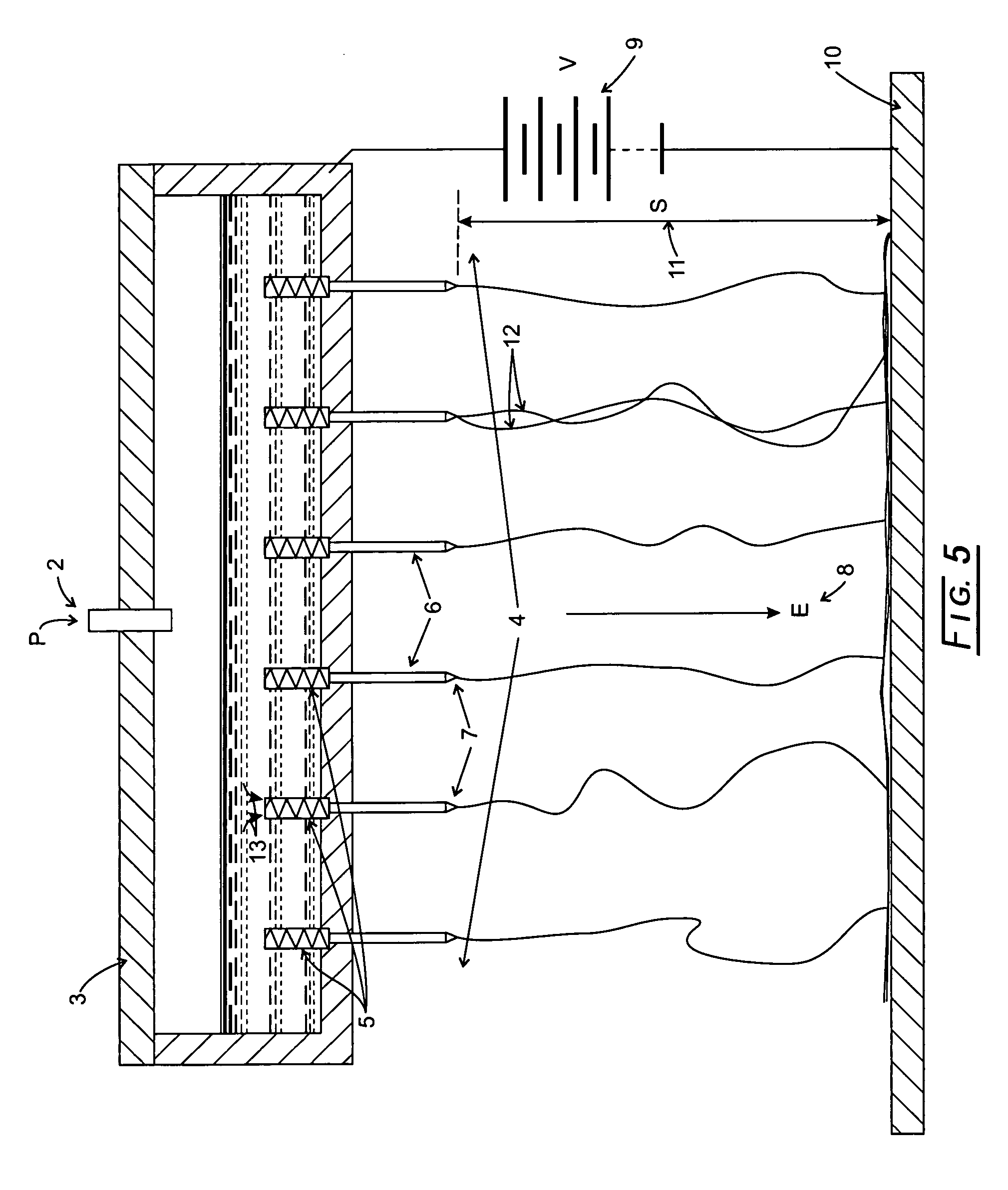Electrospraying/electrospinning array utilizing a replacement array of individual tip flow restriction
a technology of electrospinning array and individual tip, which is applied in the direction of spray nozzles, coatings, filament/thread forming, etc., can solve the problems of inability to feed pressurized fluid or a single positive displacement pump, unstable flow of liquid into the electrospinning orifice, etc., to facilitate the use of as many spraying tips and facilitate electrohydrodynamic spraying
- Summary
- Abstract
- Description
- Claims
- Application Information
AI Technical Summary
Benefits of technology
Problems solved by technology
Method used
Image
Examples
example 1
Fibrous or Micro Pore Sheet Flow Restrictor
[0032]FIG. 6 depicts a portion of a spinning array (here using tubes 6 of about 2 mm inside diameter and about 1″ apart to minimize electrostatic interactions), wherein a fibrous sheet, 20, restricts flow into each of the spraying tips. Using 24-Pound Bond paper as the fibrous sheet, we obtained a consistent flow for an water based fluid having a viscosity of μ=6.1 poise, as follows:
[0033]
14 psi.96 uL / min / tip
Using filter paper (two layers of #4 Whatman Qualitative Brand catalog #1004150) as the fibrous sheet and a water based fluid having a viscosity of μ=6.1 poise, we obtained a consistent flow, as follows:
[0034]
1 psi10 uL / min / tip5 psi31 uL / min / tip10 psi 69 uL / min / tip
[0035]Note, that the flow is measured by calculation after observing the time necessary to form a hemispherical droplet having the spraying orifice diameter (with the electrostatic field off). The high restriction to fluid flow caused by the fibrous sheet restrictor causes the...
example 2
Pinhole Replaceable Sheet
[0041]We propose the use of a small orifice, radius r or diameter d, preferably in a thin, impermeable, and replaceable sheet. This inventive flow restriction enables the spinning or spraying array to utilize liquids, which may contain small particulates.
[0042]If the liquid has very low viscosity (say, less than about 10 centipoises), we can use the kinetic energy conservation to show that the flow volume V through such a pinhole is proportional to both the square of the orifice radius and the square root of the liquid pressure across the orifice. The flow also is inversely proportional to the square root of the liquid's viscosity, to wit:
V=πr2√(2P / μ)
We find experimentally that all liquids, which electrospin well into fibers, have viscosities above about 100 centipoises. For these more viscous liquids, the above-mentioned equation does not correctly predict the orifice flow. A much closer prediction to the orifice flow may be obtained using the following cap...
PUM
| Property | Measurement | Unit |
|---|---|---|
| diameter | aaaaa | aaaaa |
| effective diameter | aaaaa | aaaaa |
| viscosity | aaaaa | aaaaa |
Abstract
Description
Claims
Application Information
 Login to View More
Login to View More - R&D
- Intellectual Property
- Life Sciences
- Materials
- Tech Scout
- Unparalleled Data Quality
- Higher Quality Content
- 60% Fewer Hallucinations
Browse by: Latest US Patents, China's latest patents, Technical Efficacy Thesaurus, Application Domain, Technology Topic, Popular Technical Reports.
© 2025 PatSnap. All rights reserved.Legal|Privacy policy|Modern Slavery Act Transparency Statement|Sitemap|About US| Contact US: help@patsnap.com



